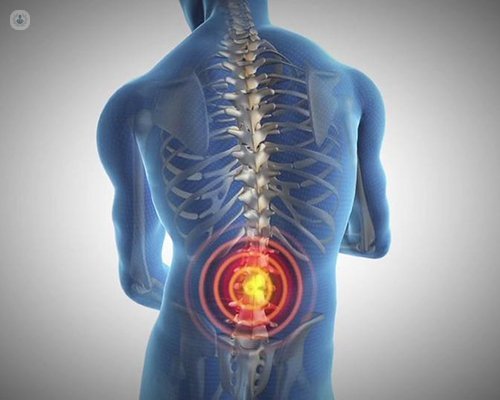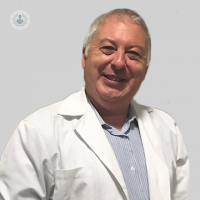Sciatica: Causes and advances in treatment
Written by:Sciatica pain is defined present throughout the course of the sciatic nerve due to the involvement anywhere in the path of the nerve trunk or roots that form. It is perceived as pain in the lower back, buttocks or various parts of the leg and foot. Sciatica is only a symptom, being essential for the treatment diagnosing the root cause of the involvement of roots or the nerve.
Sciatica: Causes
 Sciatica is usually caused by compression of the lumbar roots 4 and 5 or the sacral roots 1, 2 or 3. The most common cause is compression, which is often accompanied by a significant inflammatory component originating in an intervertebral disc herniation. Other causes are defects of vertebral alignment (spondylolisthesis), the canal stenosis caused by osteoarthritis, other degenerative pictures or the most peripheral nerve compression by muscular structures (pyramidal muscle) or tumor and fibrosis or adhesions occurred after surgery for herniated disc.
Sciatica is usually caused by compression of the lumbar roots 4 and 5 or the sacral roots 1, 2 or 3. The most common cause is compression, which is often accompanied by a significant inflammatory component originating in an intervertebral disc herniation. Other causes are defects of vertebral alignment (spondylolisthesis), the canal stenosis caused by osteoarthritis, other degenerative pictures or the most peripheral nerve compression by muscular structures (pyramidal muscle) or tumor and fibrosis or adhesions occurred after surgery for herniated disc.
A pain that is often confused with sciatica but not caused by involvement of this nerve is due to muscle trigger points located in the square lumbar and gluteus medius and minimus.
Sciatica: Diagnosis
The diagnosis is based on a proper review of the medical history (anamnesis) and physical examination, accompanied where necessary by imaging tests such as a simple radiology or MRI; and neurophysiological studies, electromyography, or sometimes scan. The aim is to assess the origin and extent of the lesion causing sciatic pain.
Sciatica: types of treatments
The most common initial treatment is anti - inflammatory analgesic drugs. Rest is better than no activity in patients who can remain active. Frequency associated neuropathic pain is high, estimated as more than 50% of mixed origin, which are used for specific drugs such pain, such as pregabalin, amitriptyline, gabapentin or muscle relaxants. The role of long-term opioid is controversial, although new drugs like tapentadol can improve outcomes by treating both somatic pain and neuropathic. Some specialists Pain Unit usually use a combination of locks associated with analgesic oral treatment that is removed as possible.
In the case of surgery accelerates the resolution of pain, but the evidence is not so clear about the long - term benefit and frequent postoperative painful consequences.
Sciatica: studies on treatments
Various international organizations have studied and concluded the results of different treatments. The recommendations of the North American Spine Society suggests that surgery of lumbar disc herniation, discectomy, provides symptomatic relief more efficiently and faster than other treatments, although less intense symptoms can be treated conservatively. It has also been found that patients with psychological problems have bad results with surgery.
The recommendations of the British Pain Society indicate that any signal compression horsetail requires referral for emergency surgery. Prolonged motor deficits or persistent pain when you have exhausted all nonsurgical measures are also indication for surgery.
A study of painful complications after spinal surgery shows that the syndrome called Failed Back Surgery can affect around 20% of patients operated column with persistent pain after surgery. The causes are multiple, from neuropathic pain to epidural fibrosis that includes nerve roots. Treatment consists of epidural steroid injections, pulsed radiofrequency or release of adhesions by epidurolysis. Notably ozone therapy cone to release the affected roots and reduce epidural fibrosis successfully concluded.
A recent review compares the results of surgery versus conservative treatment with medication infiltrations and canal stenosis. It concludes that there is no evidence of improved outcomes of surgery on conservative therapy, including epidural steroid injections, while conservative therapy does not show only undesirable effects compared with surgery, which has between 10 and 24% adverse effects and undesirable results.
The epidurals are widely used, with efficacy rates equal or superior to surgery. Applying the most recent studies concerning the safety of the technique and the correct choice of drugs used, are shown as the alternative of choice with very few side effects, especially severe or very severe. Specialists use it routinely in many occasions accompanied infiltrations with Ozone to increase efficiency and prolong the duration of effect. In certain cases other approaches may be used for locking in patients with difficult access or high risk, such as paraspinal approaches, in principle, with the same efficacy rates or transforaminal in post-laminectomy syndrome.
Other possible techniques are eliminating Percutaneous compression (nucleolysis by coablación or ozone discectomy) without surgery, but are only useful in certain hernias, according to their position or evolutionary state.
Piriformis syndrome, piriformis muscle spasms located in the area of the buttocks, treated with stretching and physical therapy to increase mobility. Sometimes muscle injections are administered under fluoroscopic, electromyography or ultrasound control. Recently they have been more effective infiltrations with collagen or botulinum toxin.
Finally note that is usually not resort to physiotherapy and rehabilitation treatment until they have completed the cycle epidural or ozone treatment. Once this has been determined, we value the use of rehabilitation, osteopathy and postural treatment through a school column.
Edited by Roser Berner Ubasos.


